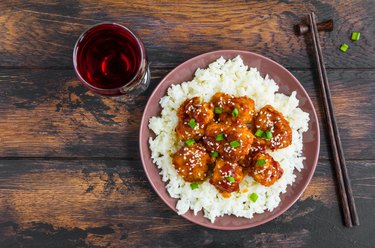
Sesame chicken is a common option in Chinese restaurants, and you can even make your own at home. Typically, it's served with sides like fried rice which add to the fat and calories in sesame chicken.
To make sesame chicken, the chicken is traditionally marinated in a mixture of soy sauce, sesame oil and salt before being deep-fried.
Video of the Day
Video of the Day
The chicken is served in a sauce featuring ginger, garlic and sesame. The chicken is generally served with white or brown rice, but fried rice is another popular option.
The nutritional value of this meal varies based on exactly what's used in the recipe, but it's possible to enjoy the dish as a nutritious addition to your diet, especially if you prepare it at home.
Sesame Chicken Nutrition
Restaurant Sesame Chicken will have varying nutrition information based on what ingredients are used and how it's made.
According to the USDA, a serving of nine pieces of sesame chicken will give you about:
- Calories: 554
- Total fat: 27 g
- Saturated fat: 5 g
- Trans fat: 0 g
- Cholesterol: 112 mg
- Sodium: 911 mg
- Total carbs: 51 g
- Dietary fiber: 1 g
- Sugar: 30 g
- Protein: 27 g
Sesame Chicken Calories and Macros
A serving of nine pieces of sesame chicken has 554 calories. This is not including additions such as fried rice or white rice.
There are 27 grams of fat in sesame chicken, and 5 grams of that is saturated fat. That's 35 percent of your recommended daily value (DV) for fat and 23 percent of your DV for saturated fat.
Sesame chicken is made with breading, which makes the dish high in carbs. You'll get about 51 grams of carbs per serving of sesame chicken, with only 1 gram of fiber, or 5 percent of your DV and a rather high 30 grams of sugar, which is 30 percent of your DV.
You will get a decent amount of protein from a serving of Sesame Chicken, 27 grams to be exact. That's about 54 percent of your DV for the muscle-building nutrient.
Cholesterol and Sodium
Sesame chicken is high in both cholesterol and sodium, which may be a concern for some people.
Having too much sodium in your diet is linked to heart health issues, and it's recommended that you limit sodium to a minimum of 2,300 milligrams per day (or closer to 1,500 milligrams) to keep your heart disease risk low, according to the American Heart Association.
Sesame Chicken With Fried Rice
Eating sesame chicken with fried rice will add to the calories, fat and carbs in your meal. Making your own at home can help you control the nutrition in sesame chicken with fried rice, but ordering it from a restaurant means you don't know exactly what's in it.
According to the USDA, a 1-cup serving of Chinese Restaurant Fried Rice gives you an additional:
- Calories: 238
- Total fat: 4 g
- Saturated fat: 1 g
- Trans fat: 0 g
- Cholesterol: 25 mg
- Sodium: 530 mg
- Total carbs: 45 g
- Dietary fiber: 2 g
- Sugar: 1 g
- Protein: 6 g
As you can see, adding fried rice to your sesame chicken meal will increase the calories by 238 bringing your total to 792 calories. The fat would increase to 31 grams and sodium to 1,441 milligrams, which is almost the full daily amount recommended by the American Heart Association.
How to Make Sesame Chicken Healthy
Sesame chicken paired with fried rice can be a nutritious meal if it's prepared with certain things in mind. It offers energy-supporting carbs and muscle-building protein.
1. Add Veggies
When vegetables such as peas and carrots are added to the meal it will provide fiber, vitamins and minerals.
Loading the dish with veggies like broccoli may also help bulk up the meal without adding a ton of extra calories and fat.
2. Don't Fry the Chicken
Usually, the oil used to deep-fry the chicken and prepare the sauce contributes a lot of fat to the dish. Roasting the chicken in the oven instead of frying it in oil will lower the total fat in your dish without compromising the protein.
3. Use Low-Sodium Sauce
The soy sauce used in the marinade and sauce is also high in sodium. Choose low-sodium soy sauce or swap it completely for coconut aminos.
4. Serve It With Another Type of Rice
If you typically eat sesame chicken with fried rice, swap the fried rice with white or brown rice instead, which will make the dish lighter and lower the calories and fat.
- Food Network; Sesame Chicken Recipe; Tyler Florence
- The Daily Plate: Sesame Chicken
- The Daily Plate: Healthy Choice Sesame Chicken
- The Daily Plate: Fried Rice
- USDA MyFoodData: Sesame Chicken
- American Heart Association: How Much Sodium Should I Eat Per Day?
- USDA MyFoodData: Chinese Restaurant Fried Rice WIthout Meat